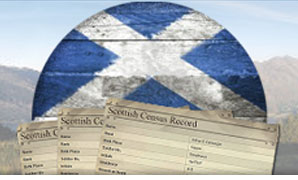Family History Guide
Articles
Introduction
General Registration of births, marriages and deaths started on 1 July 1837 and continues to the present day. By seeking General Registration records for all your direct ancestors (great grandparents, great-great grandparents and so on) you can create a detailed, interesting and accurate family tree.
Seeking births and marriages is a systematic process, that involves working back from what you know for absolute certain. Once you have an ancestor's birth certificate, it will tell you who the parents were. You can then seek the marriage of that couple prior to the birth. Unless you know the couple had older children, start immediately before the birth – a surprising amount of brides walked up the aisle pregnant. The marriage certificate will provide the couple's ages and the names of their fathers. Armed with this new information, you can then seek the births of the couple on the marriage record. You will know you have found the right certificates, because the fathers' names should match up with the fathers named on the marriage certificate.
Seeking deaths is harder, as you don't always know when people died – though family memories and the non-appearance of people in censuses is always a good clue. Sometimes it's just a question of searching forwards until the right entry is found. The records are not as detailed as birth and marriage records: they might name the spouse of a dead married person, or the parent of a dead child, and sometimes the informant of the death is a relative (most often a son or daughter), but in many cases the death record may state no family relationships at all. However, deaths are still useful tools for genealogists. They are especially good for giving precise ages for people who died before 1851, but in all cases they complete the story of your ancestors' lives. They tell you how they died, which can be useful if you're worried about inherited medical conditions. They are also another means of making sure that you really have traced the right people. 'Always kill off your ancestors' is a time-honoured piece of sound genealogical advice.
How do the records work?
Since 1 July 1837, all births, marriage and deaths in England and Wales have been registered by local registrars, who report back to the superintendent registrars of each of the country's registration districts. The superintendent registrars in turn send copies of the records they have created to the Registrar General, whose department compiles the General Registration indexes. It is these indexes that you can search on Genes Reunited, under 'Search Records'.
The indexes were compiled for each quarter of the year (January-March, called the March quarter; April-June, called the June quarter; June-September, called the September quarter, and October-December, called the December quarter). The quarterly system stopped in 1984, in which year annual indexes started being compiled instead.
Note that marriages are always indexed in the quarters in which they took place, but births can be registered up to six weeks later, so may appear in the next quarter. For example, if a child was born on 20 March, their birth might be registered quickly, so appear in the March quarter, but if the parents did not register the birth until April, then the birth entry will appear in the June quarter of that year. Deaths were usually registered straight away, but delays could take place here too, if, for example, there was a lengthy inquest or post mortem.
The indexes exist as very big, heavy books, that could be searched at Somerset House, later at St Catherine's House and finally at the Family Record Centre. They are no longer on public access anywhere, but images of the pages can be searched on Genes Reunited. When you type in a name, the pages that will appear are those on which that name might appear.
How do I search for what I want?
When you make a search in the indexes, you will usually find yourself working through a series of quarters, looking for the right entry. Keep a notebook open, and note down each quarter that you have searched, along with the specific names, and any variant spellings of those names, under which you have been searching, and write down any possibilities you encounter, in full. Such notes are a good way of avoiding missing one quarter – a mistake very easily made – and, if you do not find exactly the right entry during your first search, your notes will help you avoid duplicating what you have done already, and will help you to work out how to broaden your search to cover other variant spellings, or a wider time period or geographical area.
Note down the reference letters and numbers that appear after the registration district. You will need these when you order certificates.
In the indexes, events are identified in terms of the registration district in which they were registered. The Institute of Heraldic and Genealogical Studies in Canterbury (www.ihgs.ac.uk) produces useful national maps showing the boundaries of the registration districts. You can find out what registration district covered a specific place by looking at www.visionofbritain.org.uk or www.genuki.org.uk.
In many cases, you will not know for sure where an event took place, and therefore in which registration district it was registered, until you have the certificate in your hands. Therefore, instead of limiting your search to noting only the events that took place in just one registration district, it pays to look out for events in a wider area, as these might turn out to be relevant as well.
How can I order certificates?
The General Registration indexes on this site are not 'records' in their own right. They are simply indexes to the original records that you need. These records are held by the Registrar General's Department, and can only be obtained in the form of certificates. Once you have found the reference to your ancestor's birth, marriage or death record using the indexes, you can order the relevant certificate at the website www.direct.gov.uk/gro ('gro' stands for 'General Register Office'), or by contacting the local registrar in whose district the event was registered, ie, place listed after the name in the indexes. From 6 April 2010, the costs of certificates are £9.25 each, when ordering from the GRO, or £9 when ordering from a local registrar.
Whilst it is tempting to avoid paying for a certificate, and simply to make do with the information given in the indexes, bear I mind that the information in the indexes is considerably less than what is given on the certificates. Indeed, without paying for the certificate, you can seldom even be 100% sure that it relates to the right person.
How do I find a birth?
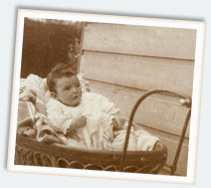
The General Registration indexes, that you can search on Genes Reunited, give the child's name (with initials instead of middle names); the registration district in which the birth was registered, and, from September 1911, the mother's maiden name. Sometimes, parents registered a birth before having decided the baby's name, and these entries appear at the end of the list of people with the surname as 'male' or 'female'.
The certificates state:
- date and place of birth. If the exact time of birth is given, the child probably belonged to a set of twins. Look in the same index for other children born in the same quarter and district, who could be your ancestor's twin.
- child's name. Children's names can be added to or altered on birth certificates for up to a year after registration, unless a baptism has occurred. The child will appear in the indexes under both the original name (or lack of it) and changed or added one, so this is unlikely to cause problems for the searcher.
- name and occupation of father. Be cautious of occupational status: there are many instances of tailors' assistants saying they were tailors, cottagers claiming to be farmers and so on.
- name and maiden name of mother. If the mother was married to the father, she will be given with her maiden and married surnames, ie, Rose Smith, formerly Evans' – Rose Evans had married the father, Mr Smith. If Rose was not married to Mr Smith, she will be given simply as 'Rose Evans'. If Rose had been married before, then she will be given with three surnames, 'Rose Smith late Jones formerly Evans'. This means that Rose was born Rose Evans, married Mr Jones, was widowed or divorced and later married Mr Smith.
- signature or mark and address of informant. This was usually a parent. Signing with a mark usually indicated illiteracy, but of course the signatory might merely have injured their hand. Sometimes, however, registrars incorrectly assumed that poor people could not sign their own names and invited them to make their marks instead, and the signatories were simply too deferential to speak up.
How do I find a marriage?
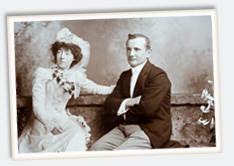
The General Registration indexes, that you can search here on Genes Reunited, give the names of the couple getting married; the registration district in which the marriage took place; and a reference number. You will seldom know in advance exactly when a marriage took place, so you may simply have to start from when their child was born, and work back. Sometimes, censuses can help cut down the search. The 1911 census says how long a couple had been married. The earlier ones don't, but they will show you how old the oldest child was, so you can start with the year when that child was born and work back.
It is best to search under the least common of the married couple's names. If John Smith married Madeleine Cumberbatch, search under Cumberbatch instead of Smith. When you find a Madeleine Cumberbatch in the indexes, note down the registration district and reference number. Then look, in the same quarter, under John Smith, and see if the same registration district and reference number appear. If so, you have probably found the right marriage, and can order the certificate.
Note, however, that the reference numbers relate to pages containing two marriage entries. There are a few unlucky cases in which John Smith and Madeleine Cumberbatch will indeed appear on the same page, but as the groom and bride in two completely weddings! In such cases, you will find out your mistake when you receive the wrong certificate, whereupon you will simply have to continue searching.
From March 1912, the indexes improve, because the name of the other party appears after the other. The name 'Cumberbatch' will be printed after John Smith's entry in the index, and 'Smith' after Madeleine Cumberbatch's, so you will know for sure that you have found the correct entry.
The certificates tell you:
- Date and place of the marriage. The parish was usually the home parish of the bride.
- Names of bride and groom. Widows are recorded under her last married name, not her maiden name.
- Marital condition - bachelor or spinster, widower or widow. If divorced, the name of the previous spouse may be recorded.
- Ages. These can be inaccurate. In many cases the bride and groom will simply state either 'full age' or 'minor'. 'Minor' means under 21. Until 1929, provided they had parental consent, boys could marry at 14 and girls at 12, and after 1929 the minimum age was 16. Marriages between such young people were rare, but they really did happen sometimes. 'Full age' means 21 or over, or under 21 but lying to avoid the need for parental consent. Sometimes, couples lied about their ages to lessen large age differences.
- Occupations. Until the mid-20th century, even if she worked 18 hour days at a coal mine or scrubbing other peoples' doorsteps, the bride's occupation was very seldom deemed worthy of recording.
- Place of residence. Generally, the bride's address is likely to have been her normal address, but grooms often took up temporary residence in the parish, usually for a minimum of four weeks, in order to be allowed to marry in the parish church.
- Names and occupations of fathers. . Mothers' names were not recorded. Fathers' occupations sometimes included an element of exaggeration – boatswains becoming captains, for example.
- Whether the marriage was by banns or license. The reading or 'calling' of banns in the parish churches of a couple who wanted to marry, for three successive Sundays before the wedding, was a means of preventing bigamy or clandestine marriages. As an alternative to having banns read, couples could apply for a marriage license, for which they swore that there was no impediment to their being married, and agreed to pay a hefty fine if they were found to have been lying. This was useful if the couple wanted to marry away from either of their home parishes, or if the bride was heavily pregnant and could not wait three weeks for banns to be read. By the 1800s, however, there was also a class distinction: many middle and upper class couples (or couples who fancied themselves to be so) opted for licenses as a matter of course.
- Signatures of bride, groom and a minimum of two witnesses, or marks, if they were illiterate.
- Name of clergyman who might sometimes be a relation.
How do I find a death?
The General Registration indexes, that you can search on Genes Reunited, give the name and the district where they were registered. Only from March 1866, unfortunately, are ages given in the indexes. From March 1969 the date of birth appears. The certificates record:
- Name of the deceased.
- Date and place of death. This will usually be the deceased's house. However, hospitals were usually recorded simply by their postal address too.
- Cause of death. As you work back into the past, you will find these becoming less informative. Many old people died in the 19th century of 'decay of nature'. If a coroner's inquest took place, this will be stated and you can look for this in local newspapers.
- Age. From June 1969, the date of birth is given instead. Bear in mind that informants often got the age of the deceased slightly wrong. Be particularly suspicious of round numbers. Was he really 80, or was he actually more like 78, or 82?
- Occupation. Married women and widows were sometimes described as 'wife' or 'widow' of their husband. When children died, they were often described as their father's child, ie, 'son of John Smith'.
- Name, address and signature of mark of the informant. The informant was often a child of the deceased, or other close relative, so this section is very useful if you are trying to trace the deceased's living descendants. However, especially after 1874, informants might also be the doctor in attendance.
What if I cannot find what I am looking for?
It is possible that the event was never recorded. Only in 1875 did parents became legally obliged to register their children's births, and were fined for not doing so. Alternatively, the event may have taken place outside England and Wales. Four categories of 'Overseas births, marriages and deaths' are also available under 'Search Records', so you might find what you want there instead. Otherwise, perhaps the event you wanted actually took place in Scotland or Ireland, or indeed the Channel Islands or the Isle of Man, all of whom have separate systems of General Registration not covered here. For General Registration systems throughout the world see www.cyndislist.com. Note that many British people were born, married and died in India, and the other British colonies in the east. For these records see, indiafamily.bl.uk/ui.
In many cases, missing' events will show up in the indexes if you broaden the scope of your search a little. Try looking in a broader range of years, or registration districts, or use variant spellings. People might appear under slightly different forenames – Ellen instead of Helen or Jack instead of John or James, for example.
What are the Overseas Births, Marriages and Deaths?
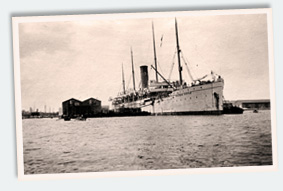
The Registrar General has a number of indexes covering births, marriages and deaths of British people outside England and Wales. These 'Overseas' events are also available here on Genes Reunited:
- Consular records of birth marriage and death of British subjects kept by British consuls from 1 July 1849.
- Birth and death at sea from 1 July 1837.
- First and Second World War armed forces deaths.
- Armed forces births, baptisms, marriages and deaths (except deaths in the two World Wars, which we have on Genes Reunited, but indexed separately), from 1761.
- Marriages abroad.These records do not contain all British people marrying abroad, so are best regarded as a form of 'lucky dip'.
Many people start tracing their ancestry assuming that their ancestors have always lived in Britain, and never strayed abroad. However, especially in the 18th, 19th and early 20th centuries, the British Empire took British people all over the globe, as sailors, soldiers, administrators, engineers, medics and, indeed, as explorers and adventurers. Many died abroad or settled there, but many more returned after their tours of duty were over, to take up jobs back home.
Thus, an amazing amount of 'British' family history involves periods spent in places as diverse as the arid plains of India, or the torrid jungles of the Far East. Sometimes, censuses will reveal this, when they show an otherwise perfectly normal family living in the suburbs of London, or an obscure country village, but with some of their children born in far-off, exotic locations.
Before the censuses, you may not find 'foreign' events in your family unless you look for them specifically. You may have a normal farm labourer in your family tree, living near his parents, with an apparently ordinary set of children. Unless you research the matter, you may never discover that he had joined up as a boy soldier, and spent his late teens clambering across the Himalayas, or sweating it out in some far-flung British post in South America. The records of armed forces births, baptisms, marriages and deaths go right back to 1761. Why not have a look? Overseas & Military Births
World War 1 and World War 2 Death Records
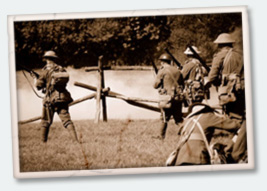
The First World War raged between 1914 and 1918, and the Second World War was fought between 1939 and 1945. In both cases, many men actually served for several years after the official end of hostilities, 'policing' the defeated countries and helping reorganise the liberated ones. The records include a wide range of casualties, ranging from those who died in battle to those who succumbed to the terrible WW2 Japanese Prisoner of War camps in the Far East. For these and all wars, you can follow up your research on the Commonwealth War Graves Commission website, www.cwgc.org and also by seeking the person's service records. Some for WW1 do not survive, but those that do are at The National Archives (www.nationalarchives.gov.uk). Those for WW2 are held by the armed forces, and are only released to the serviceperson themselves, or, if they have died, to their proven next-of-kin. The WW2 army service records, for example, are at the Army Records Centre, Ministry of Defence, Historical Disclosure, Mail Point 400, Kentigern House, 65 Brown Street, Glasgow, G2 8EX 0141 224 3030.

